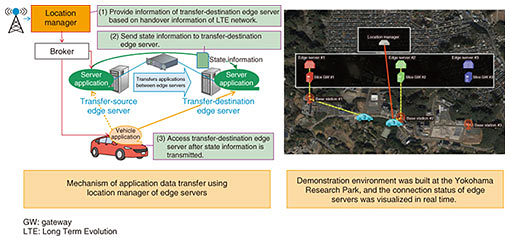 |
|||
|
|
|||
|
Short Reports Vol. 17, No. 7, pp. 42–43, July 2019. https://doi.org/10.53829/ntr201907sr2 Achievements of Government Sponsored Contract Research on Autonomous Mobility Systems Aimed at Developing an Autonomous Mobility Society in the Future1. IntroductionIn fiscal year 2017, NTT, NTT DOCOMO, and Hitachi Ltd. were entrusted along with other research institutions with contract research sponsored by the Ministry of Internal Affairs and Communications. The research project was called “Research and development (R&D) of frequency effective utilization technology corresponding to various situations supporting a vast number of autonomous mobility systems.” The companies involved have been proceeding with R&D in this project for the last two years. In this project, NTT was entrusted with researching both technologies for fast moving object edge computing (technologies to be challenged (i)) and technologies for detection and response-judgment of large amounts of abnormal traffic (technologies to be challenged (iii)), as indicated below. The results that NTT has achieved have helped to improve the target frequency utilization efficiency. The research results of the said contract research were integrated, and a demonstration event was staged at the Yokosuka × Smart Mobility Challenge 2019, which was held at the Yokohama Research Park January 24–26, 2019. The event featured panel discussions as well as an autonomous mobility system consisting mainly of cars on public roads.
2. Results of researchOne of the technologies in category (i) that NTT is developing is edge computing technology,* a kind of distributed computing technology, that is applicable to fast moving objects, mainly cars. Specifically, these technologies enable fast transfer of application data between edge servers by utilizing mobile network control information when sending and receiving large amounts of data to and from fast moving objects such as cars (Fig. 1). This makes it possible to effectively distribute large amounts of information to fast moving cars by means of distributed processing.
The technologies that NTT is developing in category (iii) include anomaly detection technology applicable to the autonomous mobility system, which enables efficient analysis of large amounts of traffic. This technology includes techniques for distributed cooperative detection of abnormal traffic, enabling the minimum information required for continuous monitoring of target mobility to be transferred from a transfer-source edge server to a transfer-destination edge server by capturing the timing of movement of autonomous mobility between edges. This enables continuous and effective monitoring of communications traffic that follows the movement of autonomous mobility between edges.
3. Future developmentThe developed technologies will be considered in light of their utilization in business activities as well as their international application and standardization by standardizing bodies. The social needs associated with the realization of autonomous driving will also be taken into account. In the future, NTT will strive to contribute to the realization of autonomous mobility systems through these efforts. For inquiries:Public Relations, NTT Science and Core Technology Laboratory Group |
|||

